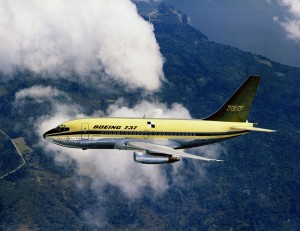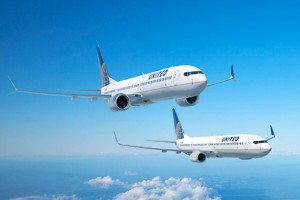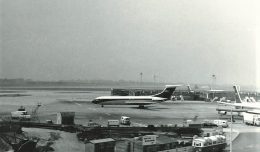With the delivery of the 8,000th Boeing 737, a -924ER variant registration N68821 to United Airlines on April 16th, a huge milestone in the history of this aircraft type was reached. The road behind is a storied one for this aircraft, the world’s best-selling aircraft, and with more than 3,700 orders still to be fulfilled, the road ahead seems to be fruitful too. The Boeing 737 series is a well-recognized aircraft – there are thousands of 737 flights daily to and from airports all over the world. According to statistics provided by Boeing, there are over 2,000 Boeing 737’s in the air at any time and on average a 737 departs or lands every 2 seconds. There are carriers that have built their entire fleets just on this aircraft type such as Southwest and Ryanair. So how did this long story start and where did this aircraft come from?
A “Classic” is Born
In late 1958, Boeing announced that they were undertaking a design study for “a twin-engined feeder airliner to complete the family of Boeing passenger jets” that would compete with the Sud-Aviation Caravelle, the British Aircraft Corporation (BAC) 111 and the Douglas DC-9. Joe Sutter, who would later also be known as the father of the Boeing 747, took the initial paper design of the Boeing 737, like its competitors a T-tailed aircraft with two aft-mounted engines, and started to look at alternatives. He cut the engines off the tail and positioned them on wing mounts similar to the Boeing 707. In November 1964, Boeing named Jack Steiner, also known as the father of the Boeing 727, as the chief engineer of the Boeing 737-100. To reduce the production time of the new aircraft, Steiner took 60% of the parts from the Boeing 727 to produce the Boeing 737, including the fuselage cross section, doors and cockpit avionics. Lufthansa became the launch customer on February 19, 1965 with the initial order of 21 aircraft followed by the order of United Airlines for 40 of the longer (stretch) -200 version on April 5, 1965.
The prototype Boeing 737 has may initial designations. Her serial number was 19437 and was a Boeing 737-130, built to Lufthansa detail specifications. Internally in Boeing, she was known as PA099. She also had three nicknames. The first was “Lil Toot” originally applied by Boeing, the second “Crew ‘O Two” due to a dispute with the Air Line Pilots Association who demanded the Boeing 737 carry a crew of 3, even though she was designed for a crew of two, and the final nickname “Fat Albert 1” was applied by NASA and that is still on the prototype aircraft to this day. The first high speed taxi tests were completed on Saturday April 8, 1967 and at 1:15pm on Sunday, April 9, 1967 with Captain Brien Wygle and First Officer Lew Wallick at the controls, she took to the skies from Boeing Field for the 2 hour 30 minute test flight landing at Paine Field. Six aircraft were involved in the flight-testing and certification program; four were -100’s with the last two being -200’s. The last three of the -100’s were eventually delivered to Lufthansa and the two -200’s were later delivered to United Airlines. After 8 months of flying and testing, the FAA finally certified the Boeing 737 on December 16, 1967. Lufthansa took delivery of their first aircraft on December 28, 1967 before entering service in February 1968. The first -200 series entered service with United in April 1968.
The first 271 aircraft were manufactured at Boeing Field because the factory in Renton was at full capacity producing the Boeing 707 and Boeing 727. In the -100 series, there were a total of 30 built that were all powered by Pratt & Whitney JT8D-7 turbofan engines and had a cabin layout for between 85 and 99 passengers. The stretch -200 model had a cabin layout between 95 and 124 passengers and was initially powered by JT8D-9 engines. In 1971, Boeing introduced the Advanced -200 model that had the more powerful JT8D-15 engines. There were many derivatives of the -200 model introduced during its life cycle including the -200C (Convertible) and the -200QC(Quick Change). The US Military also ordered the -200 variant under the military designation of the T-43. The final -200 model of the 1,114 built was delivered in 1988 to Xiamin Airlines of China on August 8, 1988. As of statistics released in August 2013, there are still 140 -200 variants still flying in the world today.
New Engines for the New Wave
In 1979 Boeing began the first revision of the Boeing 737 series. One of the first major changes to what would later be known as the “Classic” series was the change of power plant. Engine supplier CFMI was chosen and they provided the CFM56-3B-1 engine. Boeing wanted to increase the range and capacity of the aircraft while still retaining the cockpit commonality of the older variants of the series. The first specifications of the new variant, the -300, were introduced at the Farnborough Airshow in 1980. The first prototype of the -300 series, which was the 1,001st Boeing 737 built, flew on February 24, 1984. Cabin capacity increased to 149 passengers. The initial launch customer of the -300 variant was Southwest Airlines and in total there were 1,113 -300 Classics built.
In June 1986, Boeing announced the development of the stretched -400 variant following an order from Piedmont Airlines. The -400 increased the passenger capacity to 170 with a 10ft extension of the fuselage and this variant first flew on February 19,1988 and entered service in October of the same year. It’s initial design was to provide a intermediary between the -300 variant and the Boeing 757-200 and was powered by CFM56-3B2 and -3C engines. Due to fierce competition from the A320, only 486 of the variant were built.
Under pressure from customers to produce a variant that would replace the aging -200 series but maintain the -200’s passenger capacity, Boeing announced the -500 variant in 1987. The delivery customer, as with the -300 variant was Southwest Airlines with an order for 20 aircraft. The -500 first flew on June 30, 1989 and the first delivery to Southwest Airlines was on February 28, 1990. In total 389 -500’s were built. It is interesting to note that a great deal of them still fly today, especially in Eastern Europe where a lot of the Russian airlines have purchased the variant to replace aging Soviet-built aircraft.
With the advancement of modern technology that was being incorporated into the Airbus A320 family, Boeing began development of an updated series to the Boeing 737 family in 1991.
737NG: The Next Generation
After discussions with customers, the 737 Next Generation (NG) program was released on November 17, 1993. With this announcement, the -300, -400 and -500 variants were relabeled the Classic series. The more significant of the changes in the aircraft in the NG series was a redesign of the wing with a new airfoil section and increased wing span, an increase in fuel capacity and newer, quieter and more efficient CFM56-7B engines. The flight deck was also upgraded with newer, more modern avionics. The first NG aircraft to roll out was a -700 variant on December 8, 1996. It was the 2,843rd Boeing 737 produced and its maiden flight was on February 9, 1997. It was followed by the prototype -800 variant, which was introduced on June 30, 1997 and first flew on July 31, 1997, and finally the -600 variant, an equivalent for the -500 variant, which was introduced in December 1997 and its maiden flight was on January 22, 1998. The certification program consisted of 3 -600s, 4 -700s and 3 -800s and final certification was given on August 18, 1998. Since the release of the NG variants, the option of winglets has been added to all of the models with the exception of -600 variants.
Scandinavian Airlines launched the -600 variant with the introduction of the variant in September 1998. With only 69 aircraft built, it has been the shortest living of the variants. The launch customer for the -700 was again Southwest Airlines with an initial order of 63 aircraft. Additional models of the -700 variant have been the -700C that is again a convertible model and the US Navy was the launch customer for this variant designated the C-40A. Boeing developed a -700ER (Extended Range) for All Nippon Airlines which has a range of 5,510 nautical miles, the longest in the 737 family. The -700ER also evolved into the BBJ1 (Boeing Business Jet). Additional military versions of the -700 variant have also been developed, with Airborne Early Warning and Control (AEW&C) versions for the Australian, Turkish and South Korean military. To date, a total of 1,128 -700 variants have been delivered with an additional 115 BBJ1’s being delivered as well.
Hapag-Lloyd (now TUIfly) of Germany was the launch customer for the -800 variant that was seen as a direct competitor to the Airbus A320 and a replacement for the Boeing 727 and the McDonnell-Douglas MD-80 and MD-90 aircraft. A military version of the -800 variant was announced in 2004 when Boeing was awarded the contract to replace the US Navy’s P-3 Orion patrol aircraft with the P-8 Poseidon. A total of 3,219 -800 variants have been delivered. The -800 variant also evolved into the BBJ2 of which 19 have been delivered.
The -900 variant, the longest and most powerful of all of the Boeing 737 models was introduced in 1997 with the first delivery to Alaska Airlines in May 2001. There were several shortcomings in the initial -900 variant that included the fuel capacity and range of the -800 variant and so on August 8, 2006, the -900ER (Extended Range) variant was released while the original -900 model was discontinued. The BBJ3 based on the -900ER variant is the largest of the business jets based on the 737 with 1,120 square feet of interior space. A total of 292 aircraft in this variant have been delivered along with 6 deliveries of the BBJ3.
Boeing Takes It to the MAX
The next series of Boeing 737s was announced in 2011 with the 737 MAX program. The three variants in the MAX program, the -7, -8 and -9 will replace the -700, -800 and -900ER variants. The main changes to the MAX program will be the release of the latest engine from CFMI, the LEAP-1B that is the next generation of the CFM engines, and the addition of fly-by-wire to the control systems. Southwest Airlines is again the launch customer for this latest 737 series of aircraft with the first deliveries being scheduled for 2017. There are currently 1,807 orders for the MAX family.
As of November 2013, there have been a total of 154 hull losses due to accidents and hijackings that have resulted in over 4,500 fatalities in the 45+ years that this airliner has been flying.
When looking at all of the variants in the Boeing 737 family, there are more than 500 airlines around the world operating a member of the family flying to 190 countries in the world and the family represents more than 25% of the fleet of commercial jetliners in the world. This is why it is known today as the world’s best-selling aircraft.
Mark Lawrence, Producer, is a South Florida-based aviation fanatic that has been around the industry since he was a small boy. As well as being an avid photographer, he also runs his own blog that can be found at http://amateuravphoto.











